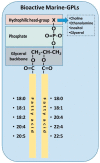Phospholipids of Animal and Marine Origin: Structure, Function, and Anti-Inflammatory Properties
- PMID: 29135918
- PMCID: PMC6150200
- DOI: 10.3390/molecules22111964
Phospholipids of Animal and Marine Origin: Structure, Function, and Anti-Inflammatory Properties
Abstract
In this review paper, the latest literature on the functional properties of phospholipids in relation to inflammation and inflammation-related disorders has been critically appraised and evaluated. The paper is divided into three sections: Section 1 presents an overview of the relationship between structures and biological activities (pro-inflammatory or anti-inflammatory) of several phospholipids with respect to inflammation. Section 2 and Section 3 are dedicated to the structures, functions, compositions and anti-inflammatory properties of dietary phospholipids from animal and marine sources. Most of the dietary phospholipids of animal origin come from meat, egg and dairy products. To date, there is very limited work published on meat phospholipids, undoubtedly due to the negative perception that meat consumption is an unhealthy option because of its putative associations with several chronic diseases. These assumptions are addressed with respect to the phospholipid composition of meat products. Recent research trends indicate that dairy phospholipids possess anti-inflammatory properties, which has led to an increased interest into their molecular structures and reputed health benefits. Finally, the structural composition of phospholipids of marine origin is discussed. Extensive research has been published in relation to ω-3 polyunsaturated fatty acids (PUFAs) and inflammation, however this research has recently come under scrutiny and has proved to be unreliable and controversial in terms of the therapeutic effects of ω-3 PUFA, which are generally in the form of triglycerides and esters. Therefore, this review focuses on recent publications concerning marine phospholipids and their structural composition and related health benefits. Finally, the strong nutritional value of dietary phospholipids are highlighted with respect to marine and animal origin and avenues for future research are discussed.
Keywords: anti-inflammatory; atherosclerosis; dairy; egg; inflammation; marine; meat; nutrition; phospholipids.
Conflict of interest statement
The authors declare no conflict of interest.
Figures



Similar articles
-
Marine omega-3 phospholipids: metabolism and biological activities.Int J Mol Sci. 2012 Nov 21;13(11):15401-19. doi: 10.3390/ijms131115401. Int J Mol Sci. 2012. PMID: 23203133 Free PMC article. Review.
-
Marine omega-3 (n-3) phospholipids: A comprehensive review of their properties, sources, bioavailability, and relation to brain health.Compr Rev Food Sci Food Saf. 2020 Jan;19(1):64-123. doi: 10.1111/1541-4337.12510. Epub 2019 Dec 10. Compr Rev Food Sci Food Saf. 2020. PMID: 33319514 Review.
-
Marine by-product phospholipids as booster of medicinal compounds.Adv Food Nutr Res. 2012;65:31-46. doi: 10.1016/B978-0-12-416003-3.00003-2. Adv Food Nutr Res. 2012. PMID: 22361179 Review.
-
[Biological properties of the mechanism of "marine" phospholipids containing omega-3 fatty acids].Ukr Biokhim Zh (1999). 2000 Jul-Oct;72(4-5):122-7. Ukr Biokhim Zh (1999). 2000. PMID: 11200440 Ukrainian.
-
Marine Carbohydrate-Based Compounds with Medicinal Properties.Mar Drugs. 2018 Jul 9;16(7):233. doi: 10.3390/md16070233. Mar Drugs. 2018. PMID: 29987239 Free PMC article. Review.
Cited by
-
Neutral Lipids, Glycolipids, and Phospholipids, Isolated from Sandfish (Arctoscopus japonicus) Eggs, Exhibit Anti-Inflammatory Activity in LPS-Stimulated RAW264.7 Cells through NF-κB and MAPKs Pathways.Mar Drugs. 2020 Sep 21;18(9):480. doi: 10.3390/md18090480. Mar Drugs. 2020. PMID: 32967264 Free PMC article.
-
Marine Bioactive Compounds as Nutraceutical and Functional Food Ingredients for Potential Oral Health.Front Nutr. 2021 Dec 2;8:686663. doi: 10.3389/fnut.2021.686663. eCollection 2021. Front Nutr. 2021. PMID: 34926539 Free PMC article. Review.
-
Dairy Fats and Cardiovascular Disease: Do We Really Need to be Concerned?Foods. 2018 Mar 1;7(3):29. doi: 10.3390/foods7030029. Foods. 2018. PMID: 29494487 Free PMC article. Review.
-
Neurobiological effects of phospholipids in vitro: Relevance to stress-related disorders.Neurobiol Stress. 2020 Sep 15;13:100252. doi: 10.1016/j.ynstr.2020.100252. eCollection 2020 Nov. Neurobiol Stress. 2020. PMID: 33344707 Free PMC article.
-
A simultaneous analysis strategy of glycerophospholipids and lipid mediators based on secondary extraction scheme.Anal Bioanal Chem. 2025 Jan;417(1):109-117. doi: 10.1007/s00216-024-05629-7. Epub 2024 Nov 9. Anal Bioanal Chem. 2025. PMID: 39516289
References
-
- Rombaut R., Dewettinck K. Properties, analysis and purification of milk polar lipids. Int. Dairy J. 2006;16:1362–1373. doi: 10.1016/j.idairyj.2006.06.011. - DOI
-
- Demopoulos C., Pinckard R., Hanahan D.J. Platelet-activating factor. Evidence for 1-o-alkyl-2-acetyl-sn-glyceryl-3-phosphorylcholine as the active component (a new class of lipid chemical mediators) J. Biol. Chem. 1979;254:9355–9358. - PubMed
Publication types
MeSH terms
Substances
LinkOut - more resources
Full Text Sources
Other Literature Sources
Medical

